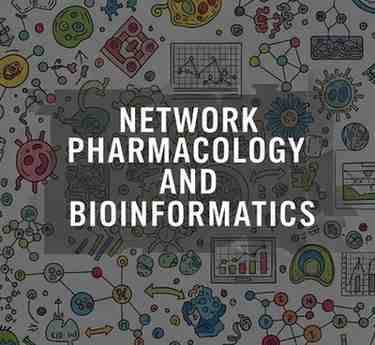
Your Account
Designed by Zeptt Technologies

Network pharmacology and bioinformatics are emerging interdisciplinary sciences that integrate computational methods, systems biology, and pharmacology.
They offer a scientific basis to validate the multitarget effects of Ayurvedic herbs, formulations, and their mechanisms of action.
These tools help in understanding how complex herbal formulations interact with multiple targets and biological networks in the body.
They are increasingly applied in Dravyaguna-Vijnana to modernize and standardize Ayurvedic medicine.
DEFINITION OF NETWORK PHARMACOLOGY
Network pharmacology is the study of complex interactions among drugs, targets, pathways, and diseases using a network-based approach.
It considers multiple components acting on multiple targets, aligning with the Yuktivyapashraya principle of Ayurveda.
It helps understand the synergy, antagonism, or modulation between different compounds in polyherbal formulations.
DEFINITION OF BIOINFORMATICS
Bioinformatics is the application of computer science, mathematics, and statistics to manage and analyze biological data.
It deals with the analysis of genomic, proteomic, and metabolomic data.
It supports Ayurveda in identifying gene-disease-herb-target interactions.
RELEVANCE OF NETWORK PHARMACOLOGY IN AYURVEDA
Ayurveda emphasizes Samanvaya (synergistic) and Yukti (rational combinations) in drug formulations.
Network pharmacology justifies the holistic approach of Ayurveda using scientific modeling.
Example: A compound like Curcumin (from Haridra) acts on multiple targets like NF-κB, COX-2, and TNF-α, explaining its anti-inflammatory and antioxidant actions.
RELEVANCE OF BIOINFORMATICS IN AYURVEDA
Identification of molecular targets for Ayurvedic herbs using bioinformatics tools (e.g., STRING, SwissTargetPrediction, GeneCards).
Mapping of genes associated with dosha-prakriti-based disease susceptibility.
Supporting Dravyaguna-Vijnana by digitizing herb-disease-action relationships.
Example: Bioinformatics analysis revealed Withaferin A from Ashwagandha targets apoptosis pathways in cancer therapy.
SANSKRIT REFERENCES FROM SAMHITAS
सर्वं द्रव्यं पंचभौतिकम्
(Cha Su 1/49)
— "All substances are composed of five mahabhutas," indicating complexity in action which suits network-based studies.
संग्रहात् बहवो गुणाः
(Cha Su 26/12)
— "Combination of many substances enhances the qualities," justifying polyherbal use in a network system.
दोषधातुमलमूलं हि शरीरम्
(Cha Su 28/4)
— “The body is based on dosha, dhatu, and mala,” these can be modeled via biological pathways in bioinformatics.
APPLICATIONS OF NETWORK PHARMACOLOGY
Identifying multiple targets of herbal drugs using network analysis.
Predicting the therapeutic effect of traditional formulations.
Creating herb-compound-target-disease networks.
Drug repurposing and identifying synergistic or antagonistic interactions.
APPLICATIONS OF BIOINFORMATICS
Genomic and proteomic databases can be used to identify molecular docking sites for phytoconstituents.
Disease-gene-drug mapping can be used for formulation standardization and personalized medicine.
Tools like PubChem, ChemSpider, KEGG, and Cytoscape help visualize compound-target-disease networks.
INTEGRATION WITH MODERN HERBOLOGY
Modern pharmacognosy focuses on single compounds, whereas network pharmacology supports multi-compound, multi-target models.
Herb-derived bioactives such as Berberine, Resveratrol, and Quercetin are studied using molecular docking and pathway mapping.
Enhances evidence-based validation of classical herbs like Guduchi, Ashwagandha, Triphala, etc.
CASE STUDIES
Triphala: Bioinformatics modeling showed that its components act on oxidative stress, inflammation, and gut health pathways.
Guduchi (Tinospora cordifolia): Network pharmacology identified its role in modulating immune response through targets like IL-6 and TLR-4.
Ashwagandha: Shown to affect GABAergic and serotonergic pathways in anxiety and sleep disorders.
TOOLS AND DATABASES USED
For Network Pharmacology: Cytoscape, STITCH, STRING, GeneMANIA, NetworkAnalyst.
For Bioinformatics: NCBI, UniProt, KEGG, SwissTargetPrediction, BindingDB, PubChem.
For Ayurvedic Integration: IMPPAT (Indian Medicinal Plants, Phytochemistry And Therapeutics database), AYUSH Research Portal.
BENEFITS IN DRAVYAGUNA-VIJNANA
Aids in understanding complex pharmacodynamics and pharmacokinetics of herbal drugs.
Facilitates reverse pharmacology and evidence-based validation.
Bridges traditional wisdom with modern data-driven science.
Supports rational formulation development, safety profiling, and dose standardization.
CHALLENGES AND FUTURE SCOPE
Lack of curated data for many Ayurvedic herbs in existing modern databases.
Need for integration of Ayurvedic Prakriti, Rasa, Vipaka, Virya, and Karma into computational models.
Future research must focus on creating indigenous Ayurvedic bioinformatics tools.
Collaboration between Ayurvedic and biomedical scientists is essential for translational outcomes.